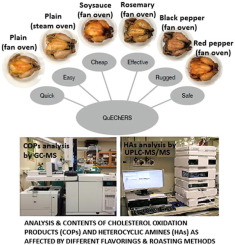Food Research International ( IF 7.0 ) Pub Date : 2020-01-18 , DOI: 10.1016/j.foodres.2020.109004 Kai-Yu Hsu , Bing-Huei Chen

|
Roasting of chicken generates many toxic compounds such as heterocyclic amines (HAs) and cholesterol oxidation products (COPs). The objectives of this study were to evaluate analysis of HAs and COPs in raw, boiled and roasted chicken by QuEChERS coupled with UPLC-MS/MS and GC-MS, respectively, and study their formation as affected by different flavorings (red pepper, black pepper, rosemary, soy sauce) and roasting methods (fan oven and superheated steam oven). Results showed that the average recovery respectively ranged from 54.1–109.3% and 65.1–116.6% for 20 HAs and from 87.9–102.8% and 87.5–101.3% for 7 COPs in the skin and meat portions of boiled chicken breast, while the coefficient of variation (CV) of the intra-day and inter-day variability for HAs respectively ranged from 5.27–12.09% and 4.23–12.68% in chicken skin, as well as 7.34–18.32% and 6.13–15.54% in chicken meat. For COPs, the CV of the intra-day and inter-day variability respectively ranged from 0.82–4.14% and 1.80–6.30% in chicken skin, as well as 1.40–9.04% and 3.02–9.81% in chicken meat. A total of 8 HAs were formed in roasted chicken, with a higher level of total HAs being shown in the skin portion of roasted chicken flavored with soy sauce and cooked in a fan oven. Also, for both roasting methods, the skin portion contained a higher level of total HAs than the meat portion, but a reversed trend was shown for total COPs with the exception of black pepper flavoring. Furthermore, in roasted chicken with 4 different flavorings, all of which showed no significant difference (p>0.05) in the correlation between formation of HAs and COPs in the skin portion, while in the meat portion, only rosemary showed significant correlation (p<0.05). By taking both skin and meat into account, the incorporation of rosemary flavoring into chicken during roasting was the most effective in inhibiting the formation of total HAs and COPs, while soy sauce flavoring was the least effective.
中文翻译:

通过控制调味剂和烘烤条件来分析和减少鸡肉中的杂环胺和胆固醇氧化产物
烧烤鸡肉会产生许多有毒化合物,例如杂环胺(HAs)和胆固醇氧化产物(COPs)。这项研究的目的是通过QuEChERS结合UPLC-MS / MS和GC-MS分别评估生鸡肉,水煮鸡肉和烤鸡肉中的HA和COP,并研究其受不同调味剂(红辣椒,黑胡椒)的影响。胡椒,迷迭香,酱油)和烘烤方法(风扇烤箱和过热蒸汽烤箱)。结果显示,在20个HA中,煮熟的鸡胸肉的皮肤和肉类部分的7个COP的平均回收率分别为54.1–109.3%和65.1–116.6%,以及87.9–102.8%和87.5–101.3%,而系数为在鸡皮中,HA的日间和日间变异性(CV)分别在5.27–12.09%和4.23–12.68%之间,以及7.34–18。鸡肉中分别占32%和6.13–15.54%。对于COP,鸡肉皮中日间和日间变异的CV分别为0.82–4.14%和1.80–6.30%,鸡肉中为1.40–9.04%和3.02–9.81%。烤鸡中总共形成了8个HA,其中,用酱油调味并用电烤箱烹饪的烤鸡的皮肤部分显示出更高水平的HA。同样,对于两种烘烤方法,表皮部分所含的总HA均高于肉类,但除黑胡椒调味剂外,总COP均显示出相反的趋势。此外,在具有四种不同风味的烤鸡中,所有皮中的HAs和COPs形成相关性均没有显着差异(p> 0.05),而肉类中,仅迷迭香显示出显着相关性(p <0.05)。考虑到皮肤和肉类,在烘烤过程中将迷迭香调味剂掺入鸡肉中对抑制总HA和COP的形成最有效,而酱油调味剂效果最差。










































 京公网安备 11010802027423号
京公网安备 11010802027423号